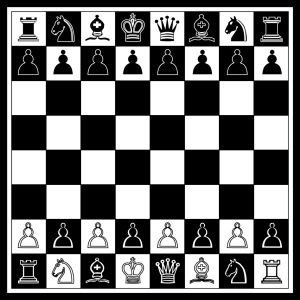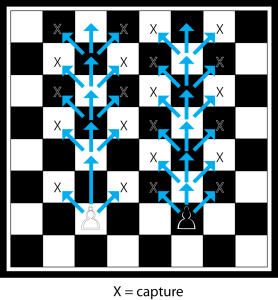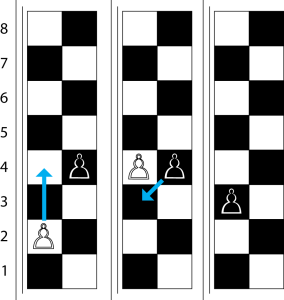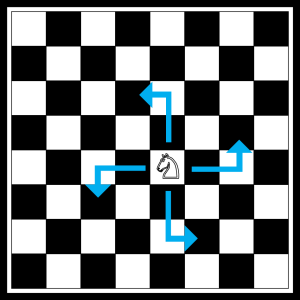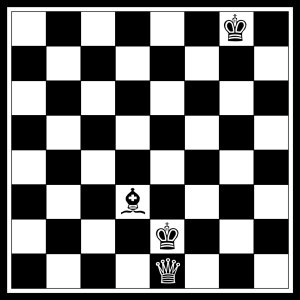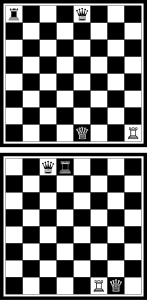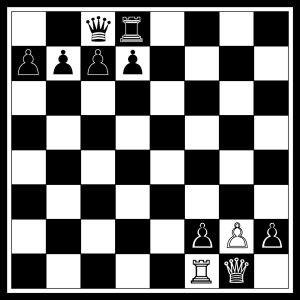Chess Rules
Goal
The goal of chess is simple: capture the King of the opponent. Even without any of the other chess pieces captured, if the King is captured, the game is ended. With all the pieces captured but the King, the game is still not ended.
Board Set Up
Chess is a game for two players. Each player has 16 chessmen (also called chess pieces). The two players are distinguished by the color of their chessmen. One player has the darker color, and the other has the lighter color. Traditionally the colors are represented as black and white. The checkered pattern is also consisted of the same two colors (one dark, one light). Each checker is called a “square”. The dark squares are called “dark” or “black” regardless of the actual color. The light squares are called “light” or “white” regardless of the actual color. The horizontal rows are called “rank”, and the vertical rows are called “files”. The coding of the squares is shown in the image below:
With the white chessmen being down the bottom, the code adds up from bottom to top (where the black chessmen are), and from the files are named alphabetically from “a” to “h” from left to right. The bottom left square of the chessboard should always be dark regardless of chessmen color.
The chessmen set fore each player is consisted of the following: 1 King, 1 Queen, 2 Bishops, 2 Knights, 2 Rooks (also called Castles), and 8 Pawns. The chessmen are put on the two ranks nearest the player.
The pawns are all set up on the second nearest rank to the player. The rest are set up on the rank nearest the player. The rooks are put in each corner of the rank. Next to the rooks are the knights. Then next to the knights are the bishops, closer and closer to the center of the row. The Queen is always set up on the square with the same color as itself. The last empty square fits the King.
Moves
Pawns
The pawns have the simplest moves. They can only go forward. Their first move can either be moving forward (to the other player’s side) one rank or two ranks. Then they can only move one rank at a time. The pawns can only capture the chessman in the diagonal square in front of them. It means they can only capture the chessman on the right or the left file on the next rank.
The pawns have more complicated rules: “en peasant” and “promotion”.
“En peasant”
When the opponent has a pawn on the fourth rank of the adjacent file, and the player makes the pawn move two squares in its first move, then the opponent can capture the player’s pawn as if it has only moved one square.
Promotion
When reaching the last rank (8th rank), the pawn can become anything but King, meaning it can be promoted to a rook, knight, bishop, or Queen. The Queen is usually chosen. The chessman used for promotion is not limited to the captured pieces, so it is theoretically possible to have extra Queens, bishops, knights, or rooks.
Rooks
Rooks, or “castles”, can move horizontally or vertically, and have no limit to the number of squares they can cross in one move. Their moves will be blocked by chessmen of their own color, or they can capture any chessman of the other color, and end their move on the square they make the capture until the next move.
Knights
Knights move in an “L” style. They can move two squares vertically, then one square horizontally. Or, they can move two squares horizontally, then one square vertically. The knight is therefore moved 3 squares in an “L” style of any direction (starting horizontally or vertically). The special property of knights is that they’re not blocked by any chess pieces except when they are blocked by chessmen of the same color on the third square of their move. They can only capture the opponent that is on the same square as the third square of their move.
Bishops
Bishops can only stay on the squares of the same color it started with. They move diagonally with no limit of the number of square they can cross with one move. Their moves are blocked by chessmen of the same color, or they will stay at the square they make capture of the opponent chessman until the next move.
Queen
The Queen can move in vertically, horizontally, or diagonally with no limit to the number of squares it can cross with one move. The Queen’s move will be blocked by chessmen of the same color, or they will stay on the square they make capture until the next move. The Queen is perhaps the most powerful piece in chess.
King
The King can move in any direction (vertically, horizontally, or diagonally), but it can only move one square at a time.
Check
A check is when the King is under attack by one or more of the opponent’s next move. The player under check can make one of the following moves:
- Move the King out of danger
- Capture the attacking piece (possible with the King itself)
- Sacrifice one of the chess pieces to save the King
Checkmate
Checkmate is sometimes called “mate”. This is the situation when no move can save the King. The game is ended with checkmate. An example of checkmate:
In the above example, the white King cannot escape from the black Queen. With any escape move it tries, it will be captured by the black Queen in the next move. If the white King tries to capture the black Queen, the black bishop waits in line to capture the white King. The white King is doomed.
Castling
There is a special move in chess where the king can more more than one square in one go. A castle is a defensive strategy that reduces the flexibility of the player who deploys castling, but provides the King the greatest defense. To make castling work, the following conditions must all be met:
- The King and the Rook that are involved must not be moved previously.
- There are no chess pieces in the way of the King and the Rook.
- The King is not in check, or the squares the King will cross or end up in must not be in check. The Rook may be under attack or pass through a square that is under attack.
- The King and the Rook must be on the same rank (unmoved, they’re on the rank closest to the player).
With pawns in front and even other chess pieces set up in defense, castling can be very strong in defense:
Castling is the only move where two pieces are moved in one move, and where the king is allowed to move more than one square.




